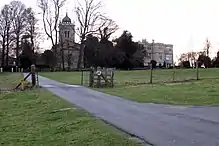Gayhurst House
Gayhurst House (now known as Gayhurst Court) is a late-Elizabethan[1] country house in Buckinghamshire, with important contributions by the Victorian architect William Burges.[1] It is located near the village of Gayhurst, several kilometres north of Milton Keynes. The house itself and the adjacent Church of St Peter are Grade I listed buildings[2][3] and the dovecot and gate piers in the grounds Grade II* listed buildings.[4]
| Gayhurst House | |
|---|---|
 Distant view of the house and adjacent church | |
| Type | House |
| Location | Milton Keynes, Buckinghamshire, England |
| Coordinates | 52.1082°N 0.7666°W |
| Built | 1597-C1603 |
| Architectural style(s) | Elizabethan |
| Governing body | Privately owned |
Listed Building – Grade I | |
| Official name | Flats 13-26, Gayhurst Court |
| Designated | 3 March 1952 |
| Reference no. | 1115951 |
 Location of Gayhurst House in Buckinghamshire | |
The house was built in the early sixteenth-century on the site of a Roman villa and Norman manor.[5] It was expanded in 1597 by William Moulsoe (a.k.a. Mulshaw, Mulsho,[5][6] Moulso,[7] and Mulso[8]) and completed by his son-in-law, Sir Everard Digby, one of the conspirators involved in the Gunpowder Plot. In spite of the Digby family's disgrace at the time, Sir Everard's widow, Mary, was able to retain the property. Ironically, both of their sons – John and Kenelm – became fervent Royalists during the English Civil War in the 1640s. During the war, parliamentary troops were billeted at Gayhurst and an inscription in the porch showing an 'X' and the date 1649 is said to have been scratched into the stone by a bored roundhead recording the execution of King Charles the First. The estate was subsequently inherited by Sir Kenelm Digby, the courtier, diplomat and natural philosopher, whose initials can be found to this day on stone pillars in the property's extensive gardens. In 1704 the estate was sold to Sir Nathan Wrighte.[1]
The house was extensively refurbished, 1858–72, by William Burges for Robert Carrington, 2nd Baron Carrington, and his son.[1] Lord Carrington was Burges' first significant patron. In total, some £20,000 was spent, which did not include the costs of construction for Burges' planned main staircase, which was never built. However, a minor stair, the Caliban Stair, was constructed.[9] The style chosen was Anglo/French Renaissance, which Burges considered in keeping with the date of Moulsoe's rebuilding.[9] Rooms contain some of his most splendid fireplaces, with carving by Burges' long-time collaborator Thomas Nicholls, in particular those in the Drawing Room which include motifs from Paradise Lost and Paradise Regained.[9] Burges's contributions to the house were not always appreciated, an undated and anonymous guidebook, probably dating from the 1970s, described his work thus; "Burges made considerable alterations and additions, mostly of a disastrous nature."
The estate has a fine series of out-buildings including a seventeenth-century dovecote, turreted stables, a brewhouse, bakehouse and dog kennels. Perhaps the most extraordinary addition is the Male Servants' Lavatory, a large circular privy based on the Abbot's kitchen at Glastonbury and surmounted by a, now-eyeless, statue of Cerberus.[9]
The park was laid out by Capability Brown and remodelled by Humphry Repton.[10] The landscaped park and formal gardens of Gayhurst are Grade II listed on the Register of Historic Parks and Gardens.[11]
The estate was broken up in the twentieth century and the house was converted into 14 flats between 1971 and 1979.[1]
Notes
- The Buildings of England: Buckinghamshire, p. 335.
- Historic England. "FLAT NUMBERS 13 TO 26 (CONSECUTIVELY) (1115951)". National Heritage List for England. Retrieved 29 March 2015.
- Historic England. "CHURCH OF ST PETER (1211931)". National Heritage List for England. Retrieved 29 March 2015.
- Good Stuff IT Services. "Listed Buildings in Gayhurst, Buckinghamshire, England". British Listed Buildings. Retrieved 12 February 2012.
- "The Owners of Gayhurst House". Milton Keynes Heritage Association. Retrieved 14 May 2020.
- Charles Thomas Boothman (1913). . In Herbermann, Charles (ed.). Catholic Encyclopedia. New York: Robert Appleton Company.
- "Gayhurst". Milton Keynes Heritage Association. Retrieved 14 May 2020.
- "Gayhurst House". Milton Keynes Heritage Association. Retrieved 14 May 2020.
- The Buildings of England: Buckinghamshire, p. 337.
- The Buildings of England: Buckinghamshire, p. 338.
- Historic England, "Gayhurst Court (1000600)", National Heritage List for England, retrieved 12 October 2017
References
- Pevsner, Nicholas & Williamson, Elizabeth, The Buildings of England: Buckinghamshire (2003) Yale University Press
- Crook, J. Mordaunt William Burges and the High Victorian Dream (1981) John Murray
- British Listed Buildings Online
